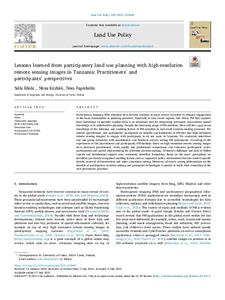Lessons learned from participatory land use planning with high-resolution remote sensing images in Tanzania: Practitioners' and participants’ perspectives
Käyhkö Niina; Eilola Salla; Fagerholm Nora
https://urn.fi/URN:NBN:fi-fe2021093048451
Tiivistelmä
Abstract
Participatory mapping (PM) solutions have become common in many sectors of society to enhance engagement of the local communities in planning processes. Especially in data scarce regions, like Africa, PM that captures local knowledge in spatially explicit form is an important tool for integrating previously non-existent spatial knowledge in to collaborative planning. Despite the increasing usage of PM solutions, there still lies a gap in our knowledge of the influence and enabling factors of PM adoption in real-world decision-making processes. We studied practitioners’ and participants’ perceptions on benefits and limitations of PM that uses high-resolution remote sensing imagery to engage with participants in six use cases in Tanzania. We conducted interviews and one group discussion with practitioners, and feedback surveys among PM participants. According to the experiences of the practitioners and participants, PM methods based on high-resolution remote sensing images have increased practitioners’ work quality and professional competence, and enhanced participants’ active participation and spatial understanding for informed decision-making. Technical challenges and lack of skilled experts and institutional support were commonly identified limitations. Based on the users’ perceptions we identified previously recognized enabling factors such as supportive policy environment but also context specific factors; removal of disincentives and wider awareness raising. Moreover, advocacy among policymakers on the benefits of participatory decision-making and geospatial technologies is needed to build their ownership of the new governance practices.
Kokoelmat
- Rinnakkaistallenteet [19207]
